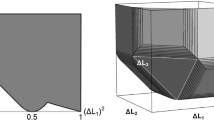Abstract
This paper presents a study of what is sometimes regarded as the conceptual heart of quantum theory, namely, the orthodox ‘physical’ interpretation of non-commuting operators as representatives of incompatible (non-simultaneously-measurable) observables. To provide a firm foundation for the analysis, a definite statement of the essentials of modern quantum theory is given briefly in the form of a mathematical axiomatization together with a review of the two measurement constructs introduced elsewhere (Park, 1967b). Contrary to custom in discussions on simultaneous measurability, the uncertainty principle is not dwelt upon but simply stated carefully in order to establish its actual irrelevance to the problem at hand. It is then demonstrated that the much quoted ‘principle’ of incompatibility of noncommuting observables is false. The axiomatic root of all incompatibility arguments is next identified; and it is shown that, with a slight modification of the basic postulates which affects neither useful theorems nor practical calculations, quantum physics no longer entails illogical restrictions on measurability. Among the related topics touched upon are the problem of joint probability distributions, the ‘logical’ approach to quantum mathematics (wherein noncommutativity becomes incompatibility within a propositional calculus), and the field theoretic attempt to unify quantal and relativistic physics through a postulated connection between incompatibility and space-like intervals.
Similar content being viewed by others
References
Arthurs, E. and Kelly, J. L., Jr. (1965).Bell System Technical journal,44, 725.
Birkhoff, G. and von Neumann, J. (1936).Ann. Math. 37, 823.
Bohr, N. (1949). In:Albert Einstsein: Philosopher-Scientist, ed. Schilpp, P., pp. 201–241. Tudor.
Cohen, L. and Margenau, H. (1967). In:Quantum Theory and Reality (Ch. 4). Springer-Verlag, 1967.
Cohen, L. (1966).Journal of Mathematics and Physics,7, 781.
Dirac, P. A. M. (1945).Review of Modern Physics,17, 195.
Einstein, A., Podolsky, B. and Rosen, N. (1935).Physical Review,47, 777.
Feynman, R. P. (1965).Quantum Mechanics and Path Integrals, pp. 96–98. McGraw-Hill.
Gleason, A. M. (1957).Journal of Mathematics and Mechanics,6, 885.
Groenewold, H. J. (1946).Physica's Gravenhage,12, 405.
Heisenberg, W. (1930).The Physical Principles of Quantum Theory. Chicago.
Jammer, M. (1966).The Conceptual Development of Quantum Mechanics, McGraw-Hill.
Mackey, G. W. (1963).Mathematical Foundations of Quantum Mechanics, p. 70. Benjamin.
Mandl, F. (1957).Quantum Mechanics. Academic Press.
Mandl, F. (1959).Introduction to Quantum Field Theory. Interscience.
Margenau, H. (1937).Philosophy of Science,4, 352–356.
Margenau, H. (1950).The Nature of Physical Reality, pp. 171–177. McGraw-Hill.
Margenau, H. (1954).Physics To-day,7, 6.
Margenau, H. and Hill, R. N. (1961).Progress of Theoretical Physics,26, 727.
Margenau, H. (1963a).Annals of Physics (U.S.A.),23, 469.
Margenau, H. (1963b).Philosophy of Science,30, 6.
Moyal, J. E. (1949).Proceedings of the Cambridge Philosophical Society,45, 99.
von Neumann, J. (1931).Annals of Mathematics,32.
von Neumann, J. (1955).Mathematical Foundations of Quantum Mechanics. English translation by R. T. Beyer, p. 351. Princeton.
Park, J. L. (1968a).American Journal of Physics,36, 211.
Park, J. L. (1968b). ‘Quantum Theoretical Concepts of Measurement.’Philosophy of Science (to be published).
Peierls, R. (1935).Nature, London,135, 957.
Piron, C. (1964).Helvetica physica acta,37, 439.
Prugovečki, E. ‘On a Theory of Measurement of Incompatible Observables in Quantum Mechanics’ (to be published).
Reichenbach, H. (1944).Philosophic Foundations of Quantum Mechanics, University of California.
Roman, P. (1965).Advanced Quantum Theory, Addison-Wesley.
Segal, I. E. (1947).Annals of Mathematics,48, 930–948.
She, C. Y. and Heffner, H. (1966).Physical Review,152, 1103.
Shewell, J. R. (1959).American Journal of Physics,27, 16.
Streater, R. F. and Wightman, A. S. (1964).PCT, Spin and Statistics and All That, p. 100. Benjamin.
Suppes, P. (1961).Philosophy of Science,28, 378; and inPhilosophy of Science: The Delaware Seminar, v. 2.
Suppes, P. (1966).Philosophy of Science,33, 14–21.
Temple, G. (1935).Nature, London,135, 957.
Varadarajan, V. S. (1962).Communications on Pure and Applied Mathematics,15, 189–217.
Wick, G. C., Wightman, A. S. and Wigner, B. P. (1952).Physical Review,88, 101.
Author information
Authors and Affiliations
Rights and permissions
About this article
Cite this article
Park, J.L., Margenau, H. Simultaneous measurability in quantum theory. Int J Theor Phys 1, 211–283 (1968). https://doi.org/10.1007/BF00668668
Issue Date:
DOI: https://doi.org/10.1007/BF00668668



